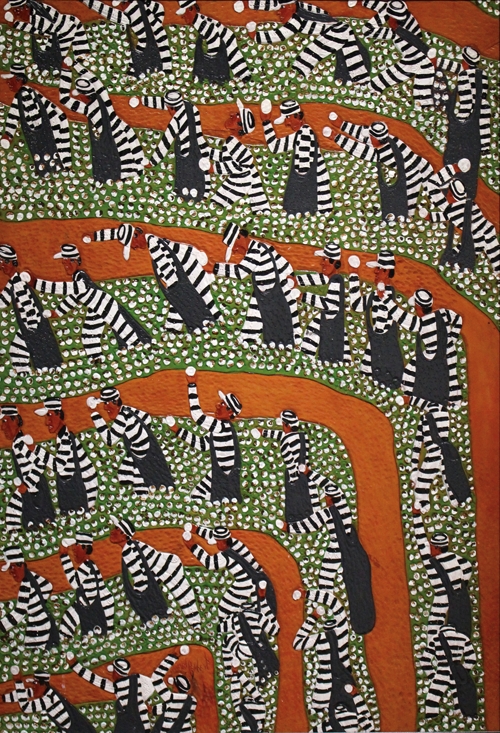A self-taught artist who grew up in the rural south during the civil rights era, folk artist Winfred Rembert draws and speaks from experience, weaving together leather, color and real-life injustices to make meaning of painful memories.
His 2015 visit to Muskegon Museum of Art was so riveting, curators and staff knew they had to bring him back for a solo show.
“When he was here, he was just incredibly dynamic and insightful and challenging,” said Art Martin, senior curator and director of collections and exhibitions. “He is a survivor of some of the real ugliness of the 1960s civil rights movement. With so many tensions dealing with issues of race and class, it’s just an opportunity to have that dialogue in our space.”
Rembert’s biography includes being given away to a relative as an infant; working in the cotton and peanut fields as a child; growing up in poverty with no formal education; and surviving a near-lynching, discrimination and hard prison time.
He learned to hand-tool leather while serving prison time for stealing a car during a civil rights demonstration, and later transformed those talents into mixed-media fine art paintings. Art became an outlet for his anger and to share the African-American experience in the pre-civil rights South.
Now, the MMA has curated its own exhibition of Rembert’s works on loan from Adelson Galleries and a few new pieces from the artist, and is devoting its main Walker Gallery to Southern Roots: The Art of Winfred Rembert throughout the winter.
In 2015, the museum’s former senior curator, E. Jane Connell, discovered Rembert and immediately took to the style of his work, Martin said. In 2015, the MMA bought one of his paintings from Adelson Galleries for the permanent collection: Chain Gang Picking Cotton #2, a mixed-media work featuring dye on carved and tooled leather. It depicts colorful, repeating patterns and rhythmic imagery of life on a chain gang.
Some of his most notable works are of prisoners dressed in black-and-white jumpsuits in the cotton fields, a life he once lived. His work also captures his Southern roots and joyous scenes of black life, jazz and dancing, pool hustlers and preachers, and playing baseball with a doll’s head. Then there’s the cotton fields, where women would give birth and immediately go back to work, and prisoners lost all dignity.
Born in 1945 in Americus, Ga., Rembert experienced racism, segregation and injustice as a poor, black male. He got involved in the civil rights movement, and police arrested him for car theft after he fled a civil rights sit-in. He escaped from jail but was eventually caught and sentenced to 27 years, serving a total of seven.
“His paintings and stories, they’re both celebratory of the life he had and at the same time they reveal the injustices and harsh realities of life,” Martin said.
His wife, whom he met while working on a chain gang, encouraged him to put his stories onto leather. Rembert didn’t start painting until he was in his 50s, but used his leather skills as a creative outlet to share his life story, which led to an exhibition at the Yale University Art Gallery in 2000.
Although he relocated to New Haven, Conn., he continues to bring his art to life — and his life to art — through saturated colors and the lively imagery, cultural vibrancy, family bonds and traditions woven into the black community. Rembert carves into large pieces of tanned leather, then paints them with leather dye to bring out what he has drawn.
“The result is just these incredibly colorful and rhythmic paintings,” Martin said. “Even though he moved to the Northeast, his work continues to be about his life in the South, about cotton, about culture, about the town and the people he knew growing up. That’s why we called it Southern Roots.”
The MMA actively collects contemporary African-American artwork and regularly features living artists, so this exhibit fits well with the museum’s broader mission to reach new audiences and engage with the African-American community, Martin said.
As part of the programming, the museum also plans to host Vivian Ducat and show her documentary, All Me: The Life and Times of Winfred Rembert. Also, in the Walker B gallery, a unique installation by Sarah Wagner, Vegetable Lamb of America, explores how the rise of cotton impacted the rise of industrialism and capitalism. And then there’s Rembert’s upcoming lecture visit, as well.
“It’s a not-to-be-missed kind of program, just phenomenally engaging,” Martin said. “It’s very raw and I think it’s good for people to hear that perspective. It makes it all real. That legacy is still there, certainly the positives, but also the negatives and he lays it all out in a really raw way.”
Southern Roots: The Art of Winfred Rembert
Muskegon Museum of Art
296 W. Webster Ave., Muskegon
Dec. 14-March 18, special artist lecture Feb. 8.
muskegonartmuseum.org, (231) 720-2570





